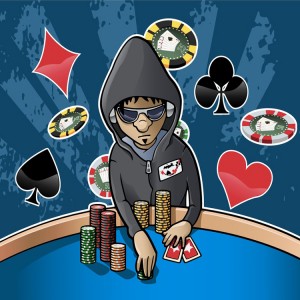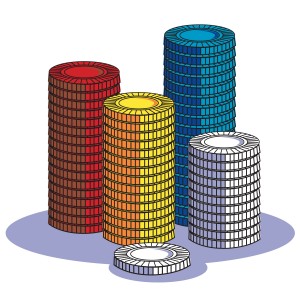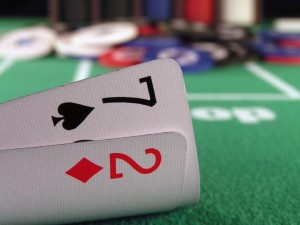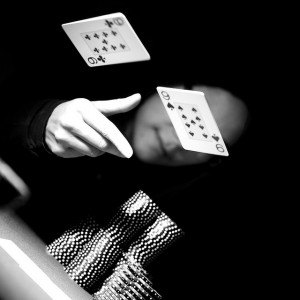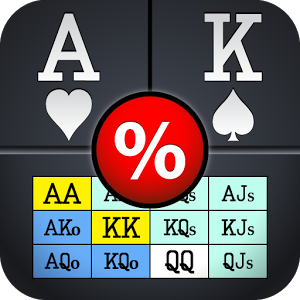We all have an idea of the archetypical bad limit hold’em player or ‘fish’ as they are often called. They are very loose, very passive, chase terrible draws, don’t value bet or protect their hand enough etc. The Poker Tracker fans out there might describe this player as something like 80/4/0.2 (at a full ring table), with these stats representing the percentage of time they voluntarily put money in the pot, the percentage of the time they raise pre-flop and their post-flop aggression factor (ratio of raises to calls) respectively. These types of players are extremely common, especially at the lower limits, but also at the mid-limits and sometimes even the higher limits.
Or at least they were in 2004, but this is 2014.
2014 isn’t as convenient as 2004. In 2014 a large proportion of those terrible players who used to donate money have either quit, got better or only play at the micro-limits where they can afford to spew money indefinitely. Sure, you will still find a few terrible players at the tables, but maybe only one or two per table at low limits and at the mid and high limits, you may have to hunt around a lot to find any at all. As most people have noticed by now, games are getting harder. It seems a long time ago that I was winning 2 big bets per 100 hands. Margins are slimmer, because the pool of bad players has diminished.
But that isn’t to say that there are no bad players at all any more. ‘Bad’ is a relative term, and in recent times we have had to adjust our expectations downwards a bit with regards to the type of players we can hope to find at the tables. It isn’t as easy as it was in 2004, but you didn’t expect the good times to last forever did you? Maybe the 80/4/0.2 fish are a rare species in this day and age, but there is still money to be won from players who make a multitude of mistakes. In this article we will look at the kind of players that donate money in 2014. The ‘New Generation Fish’ that you need to exploit in order to come out a winner. Let’s take a stroll around the four corners of the loose/tight, passive/aggressive matrix to see who we find there.
Loose/Passive Players
So what happened to the loose/passive players from 2004? Well as already mentioned, many of them quit or moved down limits, but some of them got better. A lot of loose/passive players have just become a little bit tighter and a little bit more aggressive. This may be through experience. After all, it’s only natural that if you fail at something for long enough, there’s a good chance you will eventually start to get an idea of why you are failing. Or maybe they read a few articles or flicked through a poker book at some point, just enough to identify some fundamental errors. Basically the loose/passive players are still around, but in many cases they are not as loose or as passive as they used to be. Their PT stats may now look something like 40/10/1.
Obviously these players are still profitable to play against, but not nearly to the same extent. They are playing about half as many hands, but more critically only a third as many hands that they shouldn’t be playing, because around 20% of that 40% VP$IP represents their legitimate hands. Also the loose/passive players of 2014 tend to play more sensibly post-flop. They might still chase gutshots and overcards, but at the end of the day this often isn’t as expensive a mistake as you might think, especially as they might now have just enough aggression in their game to force you to call down their raises when they hit. However, there is still immense value to be gained by value-betting these players relentlessly, especially as they will be playing with a lot of often-dominated hands such as weak aces.
Loose/Aggressive Players
The LAG population has exploded in recent years, especially at the low and mid limits. They come in all shapes and sizes and so it is very difficult to generalize too much about them. At the ‘top end’ you have the more extreme LAGs, usually referred to as maniacs. Their PT stats look something like 85/50/3 and they are extremely profitable, but unfortunately they are not particularly common these days. What are far more common in today’s games are the 35/20/3 kind of players. Loose and aggressive, but in a more tempered, refined way.
Although these players are theoretically making a lot of mistakes, their unpredictability and raw aggression can sometimes make them very challenging opponents. After playing with loose/aggressive opponents for a while, you will realise that a lot of holes in their game are papered over with aggression, especially in games where the other players are tight and they pick up a lot of pots uncontested. If everybody folds, it doesn’t matter that they were playing with a hand that they maybe shouldn’t have been
Nevertheless, LAGs can be exploited. They are playing too many hands for too many bets, so you can 3-bet them very liberally and win through judicious value betting. Obviously this is far easier with position, so always sit to their left where possible. In fact, this is so important that I would rather not have the LAG at the table at all than have him to my left. In today’s game you will rely a lot on blind stealing and winning small pots to maintain your win rate and this is difficult if you are being constantly 3-bet to your left, especially if the player has some post flop skills.
Tight/Passive Players
Back in 2004, Tight/Passive players or ‘rocks’ were quite tedious opponents. While you had an edge over them, they contributed little enough to your win rate that you would much rather they went away so that a more overt donator could potentially take their place. These days tight, passive and predictable opponents are a lot more important to you for two reasons. Firstly the overall standard of play is better, so you need to exploit every edge you can get. Often you need to look at it that a rock is taking a seat that could be occupied not by a fish but by a far better player than they are. Secondly, when fewer players are seeing the flop and most pots are won before showdown, the value of a predictable and bluffable opponent is that much higher.
These days, those tight/passive players that we used to largely ignore must now be exploited ruthlessly. Their tendency to fold without a very strong hand means you can put in a lot of bluff and semi-bluff raises in heads-up pots against them. In fact, against some opponents it is always worth putting in a bluff with your hopeless hands at some point except on very coordinated boards. You should also attack their blinds greater gusto, because you will often win the pot outright pre-flop or with a continuation bet on the flop. Another use for this type of player is somebody to sit on the right of. Often you will find yourself at a table that is a mixture of tight/aggressive and loose/aggressive players and you really want position on everybody! If there is a tight/passive player at the table, who won’t 3-bet you too often and whose blinds you can steal, it can be a great player to concede position to.
Tight/Aggressive Players
Fellow tight/aggressive players are traditionally players you would like to avoid at the poker table. Even though they do make mistakes, these mistakes will tend to be less frequent and smaller than those made by looser and more passive players. In fact, a few years ago our general policy towards other tight/aggressive players was generally to ‘stay out of their way’.
Unfortunately, this is no longer possible. There are enough good players around that it is inevitable that you will tangle with them at times, especially on the 6-max tables, which are now extremely popular. If you avoid confrontation with good players, you will soon get found out and they will bully you relentlessly. In fact, some tight/aggressive players make it their business to relentlessly bluff players they perceive to be timid, and rightly so. These days, having the ability to play correctly against other good players is vital.
Also you should be aware that some players who seem at first glance to be solid actually have large holes in their game. These need to be identified and exploited just as precisely as those of a weaker player. And because there are less bad players around than there used to be, it becomes more necessary to do so, because profits derived from ‘TAGfish’ will now make up a significant part of your expectation. Sometimes Poker Tracker stats will not tell you the complete story and you will need to observe your opponents carefully to identify their leaks.
Conclusion
It’s not easy to win at poker any more. You can’t just waltz into a table full of loose-passive fish any more, unless you play micro-limits. You not only need to practice good table selection, but you also need to accept that it isn’t 2004 any more. Many of the players that you used to destroy at the tables have improved, or moved down limits, or have just gone. Now you need to look harder for edges and exploit every one. Maybe that means going to war with the aggressive players you used to avoid. Maybe it means pushing harder at the tight player’s blinds. Maybe it means getting better at spotting when good players are slightly off their game or when they appear not to be correctly adapting to you.
Poker is getting harder and it will likely get harder still. Only the very best players will continue to be profitable, and if you want to be one of that number, you need to be continually improving and reassessing your game and opponents.
Submit your review | |

